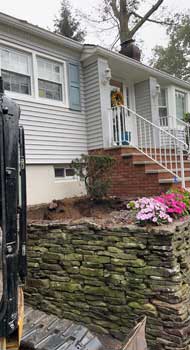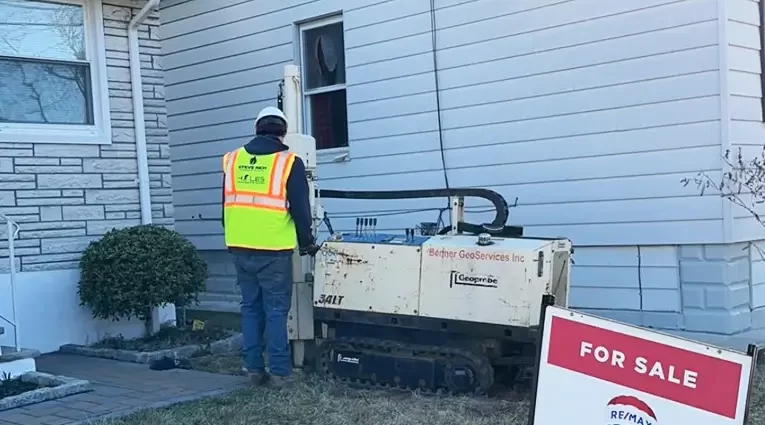Questions about any aspect of oil tank removal — from soil testing to disposal?
Why do you have to remove an oil tank in New Jersey?
Ensure the value of your house. If the underground storage tank (UST) is no longer your source of heat or you’re switching to natural gas, towns and cities will require you to remove the oil tank. If you are doing a major home renovation or landscaping, it will be more cost-effective to remove the tank while other work is being performed.
Selling your home?
Mortgage lenders and homeowners insurance companies are hesitant to fund and insure homes with a UST on the property. Potential buyers do not want to purchase and inherit the liability of leaking tanks. The older the tank, the more likely it is to leak; tanks installed before 1980 are especially prone to corrosion. If your oil delivery company deems the tank compromised, oil will not be delivered. The NJ DEP heavily regulates environmental contamination issues.
How much does it cost to remove an oil tank?
On average, where the tank is easily accessible in New Jersey, the cost to remove a 550-gallon underground storage tank usually ranges from $1,200.00 to $1,800.00.
How do you estimate the cost of an oil tank removal?
Site visits are the most important first step. Owner Steve Rich and his team are always available to answer questions. Many variables factor into pricing, including tank size, contents, and obstructions (e.g., retaining walls, walkways, trees, shrubs). We ask detailed questions to provide accurate pricing. A written proposal will be emailed for your review. We include as many possible scenarios in the contract to avoid surprises on removal day.
Why don’t we give you a flat rate?
Flat rates are often inflated to cover things that may not apply to every job. In an effort to be fair and only charge for what your specific job requires, we conduct a site visit and discuss your questions and concerns. Flat rate fees are often inflated or used to get a foot in the door. We offer guaranteed pricing or “not to exceed” agreements.
Are oil tanks covered by homeowners insurance?
Every policy is different. Typically, homeowners insurance does not cover UST removal, but check your policy. Prior to 2006, many insurers covered remediation for leaking tanks, with certain caveats. Most policies do not cover replacement of the tank or damage caused by leaks. There may be coverage under environmental cleanup or liability clauses, or through third-party endorsements.
What is the life expectancy of an oil tank?
The life expectancy depends on material, location, and maintenance. For steel tanks, especially unprotected ones, the range is typically 10 to 30 years. Corrosion is the leading cause of failure, particularly for underground tanks. Above-ground tanks can also fail due to damage or poor installation.
Why abandon an Underground Storage Tank (UST)?
If the UST is no longer your heat source, it should be removed before it leaks. In some cases, such as under historical trees or structures, abandonment may be necessary. Removal is preferred over abandonment, which is often more costly due to mandatory soil sampling. Insurance companies also favor removal.
Why is our contract so long?
To be transparent, we include as many likely and unlikely scenarios as possible. While not every detail may apply to your job, we want to avoid surprises on the day of removal.
How can I verify the certification of an underground storage tank contractor?
You can verify certification through your state or local environmental agency. You can also ask the contractor directly for a copy of their license.
How do you find a certified firm?
The New Jersey Department of Environmental Protection maintains a list of certified environmental contractors, including oil tank removal specialists.
Do I have questions on certifications, do I need one to remove an underground storage tank?
Yes. You must hire a certified contractor to remove a UST. Certification ensures proper procedures and compliance with local regulations. NJDEP also requires training, OSHA compliance, and confined space certification.
If the oil tank is not leaking or causing problems, can’t I just ignore it?
Abandoning or ignoring an old oil tank is only delaying the inevitable. Older steel tanks, especially single-wall models, will eventually leak due to rust and corrosion. Even if the tank is intact, the connected piping may fail. If you’re not using the tank, it’s best to remove it before problems arise.
The house I want to purchase has an oil tank. What should I do?
If you don’t want the tank, consider asking the seller to remove it before closing. If the tank is inactive, removal is usually required. If still in use, we strongly recommend testing the tank. Find answers to questions about oil tank testing here.
How can I choose the right oil tank removal company?
Experience matters. Verify that the company is licensed and local. Look at reviews, but apply common sense—no company is perfect. Be wary of businesses with only five-star reviews, as some remove negative feedback. Mistakes happen, and transparency is key.
What are underground oil tanks?
On residential properties, USTs are typically unregulated by the New Jersey Department of Environmental Protection (though local ordinances still apply). These tanks were used to store heating oil for home use.
Is it possible to receive assistance in paying for oil tank removal?
Currently, the NJDEP does not cover oil tank removal, but they may fund most remediation costs if the tank leaks and you qualify. This assistance often covers a large portion, though not always 100%.
Does oil tank removal take a long time?
In most cases, oil tank removal takes only a few hours, depending on access, location, and inspection requirements.
What happens if a leak or holes are discovered during my oil tank removal?
Leaks must be reported to the NJDEP hotline. Yes, it will cost more, but many cases are eligible for funding. Over the past 10 years, Steve Rich Environmental Contractors has seen:
- 63% of leak remediation jobs cost under $4,500
- 28% under $9,700
- 5% between $10,000–$20,000
- The remainder over $20,000
Many of these costs were reimbursed by the NJDEP PUST fund, with some clients also receiving new lawns or driveways.
Is the tank full?
Most are not. Regardless, we handle the safe recycling of any oil left in the tank.
Is the tank leaking?
This is usually determined during removal when the team and building inspector visually inspect the tank.
Is the soil contaminated by a leaking tank?
Soil contamination is evaluated by a Licensed Site Remediation Professional (LSRP) or NJDEP Subsurface Evaluator. If visible oil or product is found, our team will point it out.
What is the cost to remediate soils?
- 63% cost under $4,500
- 28% cost under $9,700
- 5% ranged from $10,000–$20,000
- The rest exceeded $20,000
Most were covered by the NJDEP PUST fund for eligible homeowners.Find answers to questions at their website.
Do I need a permit?
Yes, for all active tanks and those not previously abandoned.
Who is responsible for permitting?
Steve Rich Environmental Contractors (SREC) handles all permits and the entire process.
Can I remove the tank myself?
Technically yes, but you must hire a licensed consultant to obtain permits and oversee the work.
My tank is under an asphalt driveway or concrete walk. Do I have to remove it?
Yes. SREC has a sister company that handles all necessary asphalt and concrete repairs—one call does it all.
Is my underground oil tank regulated?
Home heating oil tanks, including those in large apartment buildings, are generally unregulated by the state—unless they have leaked.
After signing a contract, how long do you have to wait for the job to begin?
Work starts after local permits are issued and utility mark-outs are completed to locate underground lines.
How many days does it take to completely remove a UST?
Usually less than one day.
What happens to the oil in my oil tank?
Any remaining fuel oil is removed using our licensed vacuum truck and taken to an NJDEP-approved recycling facility.
My oil tank was removed, and I am told that I need remediation. The company did not take any soil samples but said the tank had holes.
This is a common situation. Please visit the following page for more details: What do I do when my oil tank leaks?
Why are underground heating oil tanks a concern?
Historically made of steel, USTs have a limited lifespan. Over time, corrosion or welding seam failure can cause leaks. Leaking Underground Storage Tanks (LUSTs) pose environmental, safety, legal, and financial risks. Heating oil leaks can contaminate soil and groundwater. Homeowners are legally responsible for cleanup, and remediation costs can start at $10,000 and rise significantly based on contamination levels.
If you have any questions not answered here, please reach out to us by phone ### or sent us an email.





